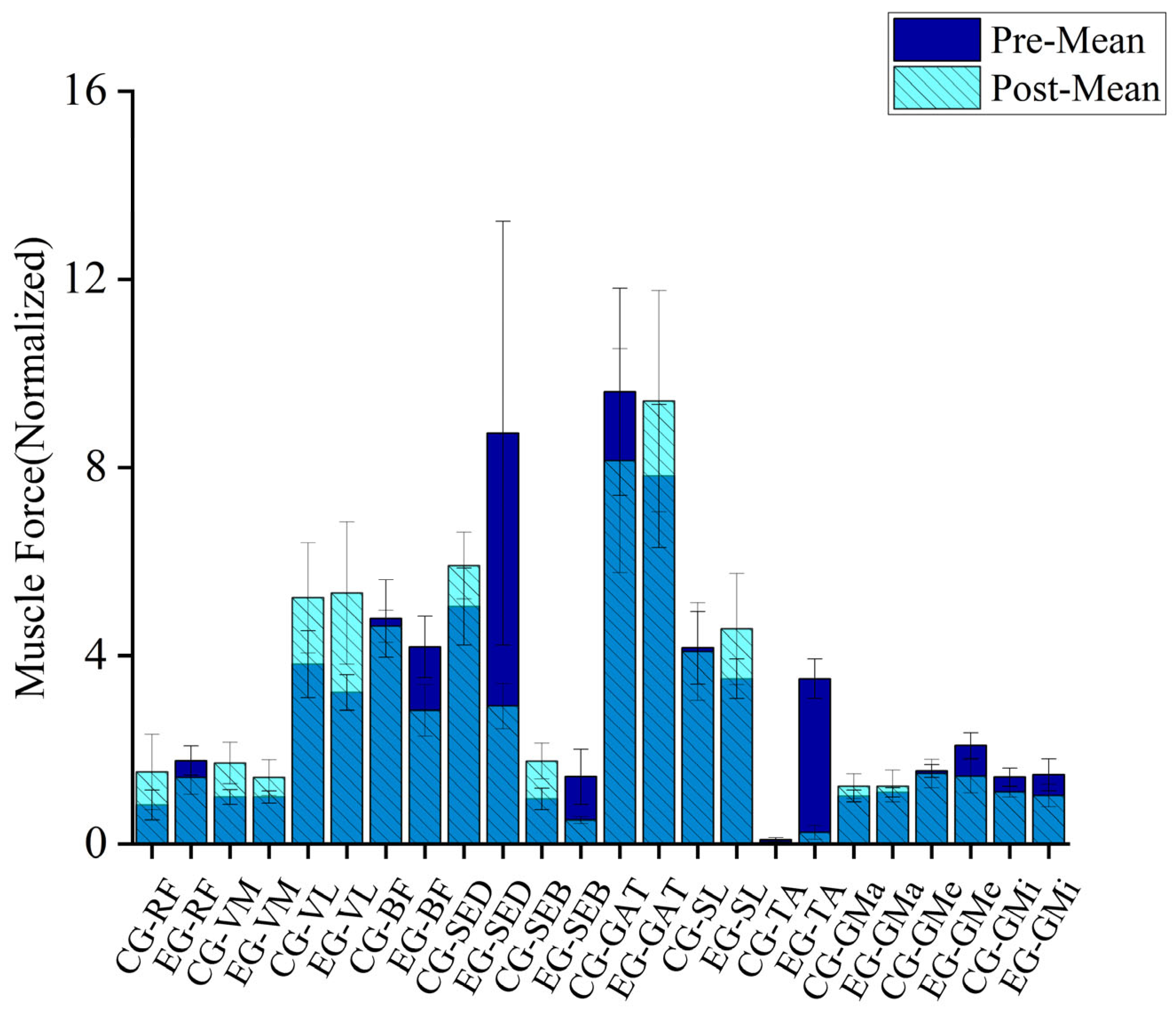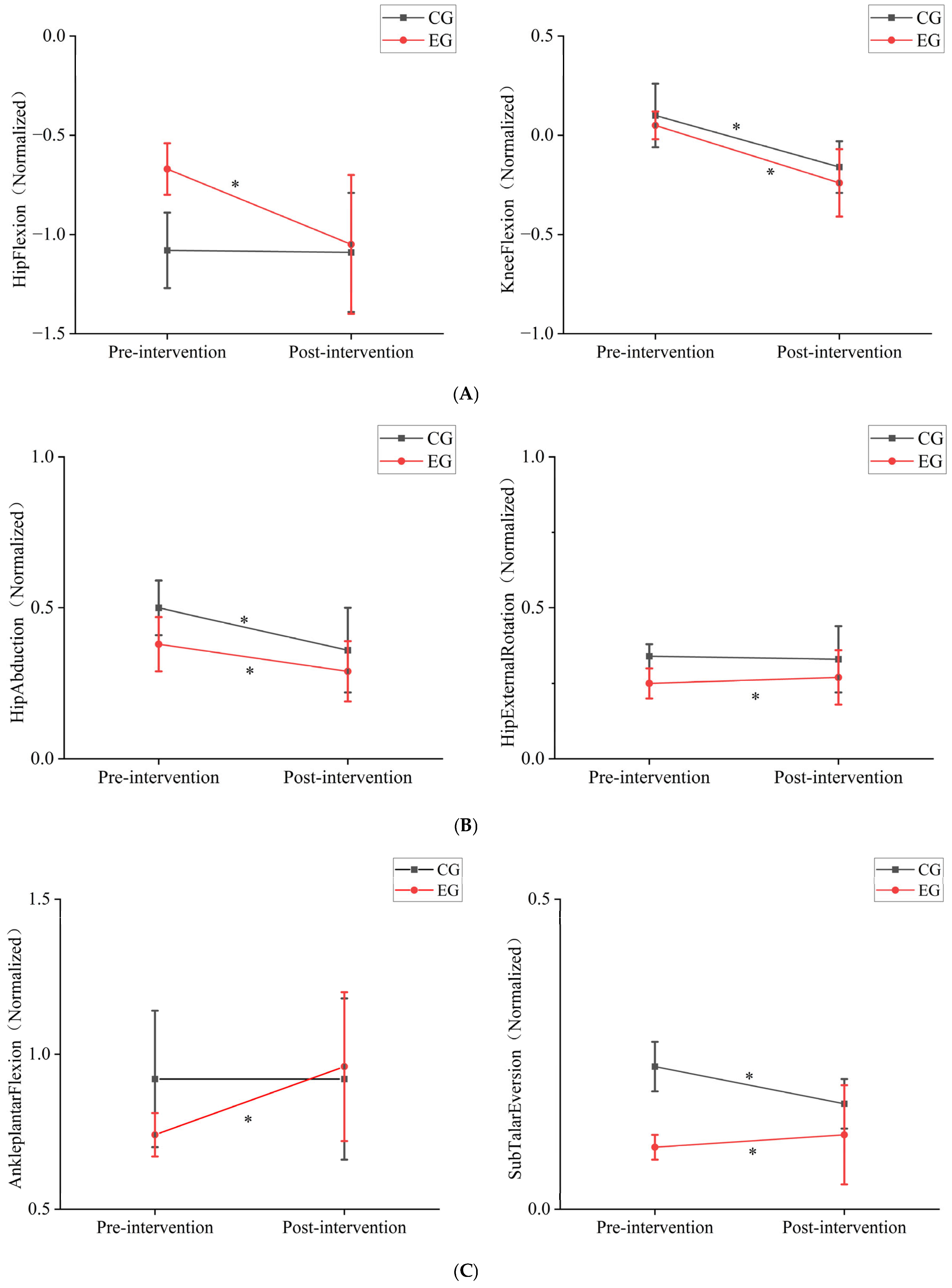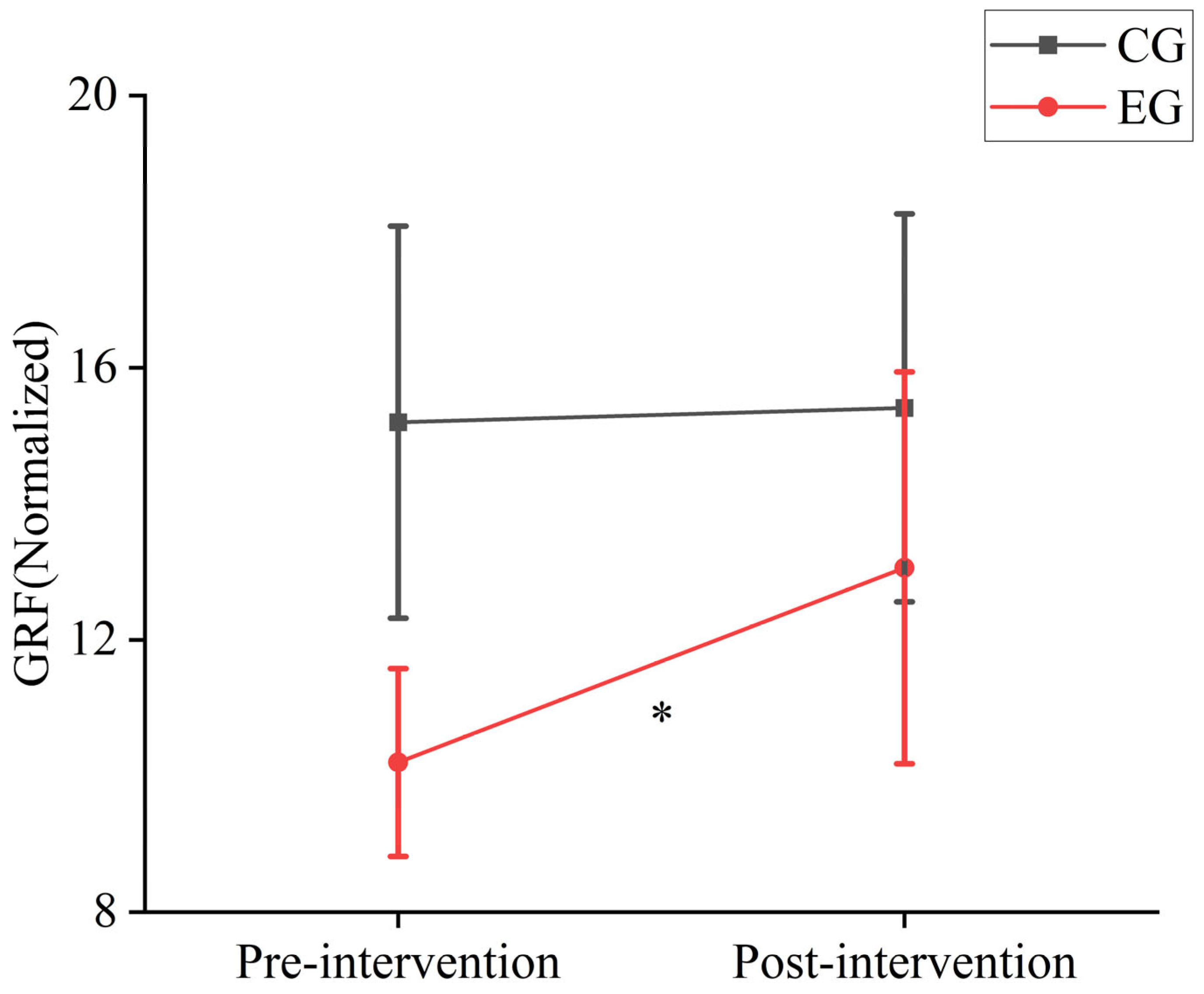The Impact of Exercise Play on the Biomechanical Characteristics of Single-Leg Jumping in 5- to 6-Year-Old Preschool Children
Abstract
:1. Introduction
2. Participants and Methods
2.1. Participants
2.2. Methods
2.2.1. Exercise Game Intervention and Control
2.2.2. Data Collection
2.2.3. Data Analysis
2.2.4. Statistical Analysis
3. Results
3.1. Joint Angles
3.2. Muscle Force
3.3. Joint Torque
3.4. Ground Reaction Force (GRF)
4. Discussion
4.1. The Impact of Exercise Game Intervention on Lower Limb Joint Mechanical Characteristics in Children
4.2. The Impact of Exercise Game Intervention on Ground Reaction Forces in Children
5. Conclusions
Author Contributions
Funding
Institutional Review Board Statement
Informed Consent Statement
Data Availability Statement
Conflicts of Interest
References
- David, F.S.; Jacqueline, D.G.; Stephen, J.L.; Mary Ann, R.; Mary, E.R.; Clersida, G.; Luis Eugenio Valdés, G. A Developmental Perspective on the Role of Motor Skill Competence in Physical Activity: An Emergent Relationship. Quest 2008, 60, 290–306. [Google Scholar] [CrossRef]
- António, A.; José, M.; Mikis, D.S.; Élvio Rúbio, G.; Martine, T.; Johan, L.; Alexandra, Q.T.; Duarte, L.F. Gross motor coordination and weight status of Portuguese children aged 6–14 years. Am. J. Hum. Biol. 2015, 27, 681–689. [Google Scholar] [CrossRef]
- Rhodri, S.L.; Jon, L.O.; Michael, G.H.; Craig, A.W. Reliability and validity of field-based measures of leg stiffness and reactive strength index in youths. J. Sports Sci. 2009, 27, 1565–1573. [Google Scholar] [CrossRef]
- Savvas, L.; Eleni, B.; Dimitrios, P.; Konstantinos, H.; Filippos, K.L.; Christos, K. Biomechanical Comparison in Different Jumping Tasks Between Untrained Boys and Men. Pediatr. Exerc. Sci. 2013, 25, 101–113. [Google Scholar] [CrossRef]
- Inga, S.; Dace, A. PEDAGOGICAL PROCESS FACILITATING PHYSICAL ACTIVITY OF PRE-SCHOOLERS. Sabiedrība Integrācija Izglītība 2019, 2, 619–628. [Google Scholar] [CrossRef]
- Ali, B.; Sally Taunton, M.; Angela, S.; Stephen, G.; Alexandra, S.; Miedema, B.; Mary, W.W.; Chandler, C.; Nalda, W.; Danielle, D.W.; et al. SKIPping With PALS: Exploring Parental Engagement in a Motor Intervention for Their Preschool Children. Res. Q. Exerc. Sport 2022, 94, 668–677. [Google Scholar] [CrossRef]
- Cecilia Ruíz, E.; Jaime, A.; Inmaculada, M.; Arturo, J.M. Analysis of Motor Intervention Program on the Development of Gross Motor Skills in Preschoolers. Int. J. Environ. Res. Public Health 2020, 17, 4891. [Google Scholar] [CrossRef]
- Aleksandra Aleksić, V.; Borko, K.; Bojan, M. Effects of a 12-Weeks Yoga Intervention on Motor and Cognitive Abilities of Preschool Children. Front. Pediatr. 2021, 9, 799226. [Google Scholar] [CrossRef]
- Zuozheng, S.; Xiu-Qun, Y.; Xinru, Z.; Weihua, Z.; Yuxin, D.; Jian, L. An empirical study of the Flag Rugby game programme to promote gross motor skills and physical fitness in 5-6 year old preschool children. Res. Sq. 2024, 60, 290–306. [Google Scholar] [CrossRef]
- Valentina, B.; Valeria, T.; Federica, B.; Caterina, P. Cognitively enriched physical activity may foster motor competence and executive function as early as preschool age: A pilot trial. Phys. Educ. Sport Pedagog. 2021, 28, 425–443. [Google Scholar] [CrossRef]
- Sofiya, A.; Ogechi, N.; Manneh, G.; Jasmin, R.; Albert, M.; Sanyog, G.S. Effects of Locomotor Skill Program on Minority Preschoolers’ Physical Activity Levels. Pediatr. Exerc. Sci. 2012, 24, 435–449. [Google Scholar] [CrossRef]
- Eleni, D.; Iliana, B.; Evridiki, Z. implementing intervention movement programs for kindergarten children. J. Early Child. Res. 2006, 4, 5–18. [Google Scholar] [CrossRef]
- Gutmann, A.; John, E.A.B. Metabolic cost of human hopping. J. Exp. Biol. 2017, 220, 1654–1662. [Google Scholar] [CrossRef] [PubMed]
- Satoshi, H.; Yoshiko, K.; Masanori, Y.; Kota, S.; Yasuko, O.; Hideyuki, O.; Tomio, H.; Mitsuru, K.; Masumi, I.; Asami, N. Applicability of the Movement Assessment Battery for Children-Second Edition (MABC-2) for Japanese Children Aged 3–6 Years: A Preliminary Investigation Emphasizing Internal Consistency and Factorial Validity. Front. Psychol. 2018, 9, 1452. [Google Scholar] [CrossRef]
- Li, J.; Diao, Y. A Comparative Study on the Development of Fundamental Motor Skills in Children Aged 3 to 10 Years. China Sport Sci. Technol. 2013, 49, 129–132. [Google Scholar] [CrossRef]
- Natsuki, S.; Shinsuke, Y.; Senshi, F. Free-leg side elevation of pelvis in single-leg jump is a substantial advantage over double-leg jump for jumping height generation. J. Biomech. 2020, 104, 109751. [Google Scholar] [CrossRef]
- Matthew, B.; Jianhua, W. Comparison of whole-body vertical stiffness and leg stiffness during single-leg hopping in place in children and adults. J. Biomech. 2017, 56, 71–75. [Google Scholar] [CrossRef]
- Matthew, B.; Jianhua, W. Vertical stiffness and center-of-mass movement in children and adults during single-leg hopping. J. Biomech. 2016, 49, 3306–3312. [Google Scholar] [CrossRef]
- Hiroaki, H.; Koh, I.; Tetsuro, M.; Kohei, O.; Masanori, S.; Kazuyuki, K. Leg stiffness adjustment for a range of hopping frequencies in humans. J. Biomech. 2010, 43, 506–511. [Google Scholar] [CrossRef]
- Erik, E.S.; Laura, C.D.; Pamela, J.R.; Ronald, V.C. Effects of Developmental Stage and Sex on Lower Extremity Kinematics and Vertical Ground Reaction Forces During Landing. J. Athl. Train. 2005, 40, 9–14. [Google Scholar]
- Peter, C.R.; Tine, A.; Erik, B.S. Joint dynamics and intra-subject variability during countermovement jumps in children and adults. J. Biomech. 2016, 49, 2968–2974. [Google Scholar] [CrossRef]
- Zhao, P.; Ji, Z.; Wen, R.; Li, J.; Liang, X.; Jiang, G. Biomechanical Characteristics of Vertical Jumping of Preschool Children in China Based on Motion Capture and Simulation Modeling. Sensors 2021, 21, 8376. [Google Scholar] [CrossRef] [PubMed]
- van Arthur, S.; Marij, E.R.; Maarten, F.B.; Huijing, P.A.J.B.M.; Schenau, G.J.v.I. A comparison of one-legged and two-legged countermovement jumps. Med. Sci. Sports Exerc. 1985, 17, 635–639. [Google Scholar] [CrossRef]
- Pablo, F.; Andrew, J.H. Ground Reaction Force Differences in the Countermovement Jump in Girls With Different Levels of Performance. Res. Q. Exerc. Sport 2013, 84, 329–335. [Google Scholar] [CrossRef]
- Cheryl, L.H.; Wells, R.W. A work-energy approach to determine individual joint contributions to vertical jump performance. Eur. J. Appl. Physiol. Occup. Physiol. 1983, 50, 247–254. [Google Scholar] [CrossRef]
- Sophie Lykkegaard, R.; Michael, V.; Erik, B.S.; Tine, A.; Finn, B.M.; Kurt Klaudi, K. Choice of jumping strategy in two standard jumps, squat and countermovement jump-effect of training background or inherited preference? Scand. J. Med. Sci. Sports 1999, 9, 201–208. [Google Scholar] [CrossRef]
- Andrew, J.H.; Willie, R.; Kevin, H. Functional data analysis of joint coordination in the development of vertical jump performance. Sports Biomech. 2007, 6, 199–214. [Google Scholar] [CrossRef]
- Athanasios, V.; Adrian, L. A biomechanical analysis of good and poor performers of the vertical jump. Ergonomics 2005, 48, 1594–1603. [Google Scholar] [CrossRef]
- Irineu, L.; Lucas, A.P.; Ronaldo, K.; Vinícius, Z.; Kátia, K.; César Cavinato Cal, A.; Fábio Yuzo, N. Transference effect of vertical and horizontal plyometrics on sprint performance of high-level U-20 soccer players. J. Sports Sci. 2015, 33, 2182–2191. [Google Scholar] [CrossRef]





| Game Name | Purpose of the Game | Method of the Game |
|---|---|---|
| Dribbling relay | Ball dribbling ability | Groups are divided, standing at both ends with a 10 m gap, performing a face-to-face dribbling relay. |
| Tug of war | Enhances coordination of large muscle groups in the upper and lower limbs | Teams are randomly divided into two groups for a tug of war competition based on the number of participants. |
| Jump rope relay | Practice single- or double-leg jumping ability | Groups are divided, standing at both ends with a 15 m gap, performing a running jump rope relay. |
| Chase and run | Develops lower limb strength and body control ability | In pairs, one person stands on one foot while lifting the other foot, and they chase each other. |
| Accuracy kicking | Develops kicking ability | Kicking balls of different colors into the goal, with the size of the goal randomly changing during the exercise. |
| Look at the sky from behind | Develops rolling and crawling ability | Facing the mat, bending the body to look at the sky between the legs, with protective assistance, subtly introducing forward roll practice. |
| Accuracy throwing | Develops upper limb throwing ability | Throwing sandbags into a basket from different distances. |
| My paper airplane flies the furthest | Develops coordination between upper limb throwing and lower limb coordination | Throwing paper airplanes made during craft class in a flying competition during break time, seeing whose airplane flies the farthest. |
| I can hang on | Practice gripping ability | Hanging on the horizontal bar competition, with assistance from the teacher to flip over. |
| Tail pulling | Practice acceleration and directional running ability | Using tails of different colors for grouping, pulling each other’s tails while protecting one’s own tail. |
| Accuracy hitting | Practice hitting balls with hands | Self-throwing and self-hitting a volleyball to see who can hit the balloon into the designated goal. |
| Distance hitting | Practice controlling hitting ability | After forming groups, practice hitting a baseball for distance. |
| Placement of Marker Points | Number |
|---|---|
| C7 vertebra | 1 |
| Left/right acromion | 2 |
| Left/right anterior superior iliac spine | 2 |
| Midpoint between left and right posterior superior iliac spines | 1 |
| Left/right greater trochanter | 2 |
| Left/right mid-thigh | 2 |
| Left/right lateral tibial condyle | 2 |
| Left/right fibular head | 2 |
| Left/right mid-calf | 2 |
| Left/right lateral malleolus | 2 |
| Left/right heel | 2 |
| Left/right fifth metatarsal | 2 |
| Joint Angle (Degree) | Pre-CG (Mean ± Std) | Post-CG (Mean ± Std) | Pre-EG (Mean ± Std) | Post-EG (Mean ± Std) |
|---|---|---|---|---|
| Hip flexion | 25.14 ± 4.97 | 26.80 ± 6.56 * | 23.66 ± 4.57 | 28.90 ± 7.11 * |
| Hip abduction | 8.48 ± 2.11 | 7.81 ± 3.43 | 4.35 ± 1.99 | 7.06 ± 2.77 * |
| Hip external rotation | 1.60 ± 0.94 | 1.79 ± 0.78 | 0.10 ± 0.24 | 1.69 ± 1.79 * |
| Knee flexion | 30.08 ± 7.10 | 36.35 ± 7.11 * | 33.74 ± 6.79 | 39.87 ± 9.27 * |
| Ankle plantar flexion | −7.05 ± 7.91 | −13.05 ± 7.56 * | −10.76 ± 7.52 | −13.46 ± 8.57 * |
| Subtalar eversion | −17.42 ± 3.77 | −11.50 ± 1.93 * | −2.06 ± 3.51 | −13.63 ± 3.04 * |
| Muscle Force (Normalized) | Pre-CG (Mean ± Std) | Post-CG (Mean ± Std) | Pre-EG (Mean ± Std) | Post-EG (Mean ± Std) |
|---|---|---|---|---|
| Rectus femoris | 0.83 ± 0.32 | 1.53 ± 0.80 * | 1.77 ± 0.31 | 1.41 ± 0.35 * |
| Vastus medialis | 1.00 ± 0.16 | 1.72 ± 0.44 * | 1.00 ± 0.13 | 1.41 ± 0.38 * |
| Vastus lateralis | 3.82 ± 0.71 | 5.23 ± 1.17 * | 3.22 ± 0.38 | 5.33 ± 1.51 * |
| Biceps femoris | 4.79 ± 0.82 | 4.63 ± 0.34 | 4.19 ± 0.65 | 2.84 ± 0.55 * |
| Semitendinosus | 5.05 ± 0.82 | 5.92 ± 0.71 * | 8.73 ± 4.50 | 2.93 ± 0.48 * |
| Semimembranosus | 0.96 ± 0.23 | 1.76 ± 0.38 | 1.43 ± 0.59 | 0.51 ± 0.07 * |
| Gastrocnemius | 9.61 ± 2.20 | 8.15 ± 2.38 * | 7.82 ± 1.52 | 9.41 ± 2.35 * |
| Soleus | 4.17 ± 0.77 | 4.09 ± 1.04 # | 3.51 ± 0.42 | 4.57 ± 1.18 * |
| Tibialis anterior | 0.09 ± 0.04 | 0.04 ± 0.05 | 0.60 ± 0.42 | 0.25 ± 0.15 * |
| Gluteus maximus | 1.02 ± 0.13 | 1.23 ± 0.26 | 1.10 ± 0.10 | 1.23 ± 0.34 |
| Gluteus medius | 1.55 ± 0.14 | 1.50 ± 0.30 | 2.09 ± 0.27 | 1.44 ± 0.35 * |
| Gluteus minimus | 1.42 ± 0.19 | 1.11 ± 0.11 * | 1.47 ± 0.34 | 1.03 ± 0.24 * |
| Joint Torque (Normalized) | Pre-CG (Mean ± Std) | Post-CG (Mean ± Std) | Pre-EG (Mean ± Std) | Post-EG (Mean ± Std) |
|---|---|---|---|---|
| Hip abduction | 0.09 | 0.14 * | 0.38 0.09 | 0.10 * |
| Hip flexion | 0.19 | 0.30 | 0.13 | 0.35 * |
| Hip external rotation | 0.04 | 0.11 | 0.05 | 0.09 * |
| Knee flexion | 0.16 | 0.13 * | 0.07 | 0.17 * |
| Ankle plantar flexion | 0.22 | 0.26 | 0.07 | 0.24 * |
| Subtalar eversion | 0.04 | 0.04 * | 0.02 | 0.08 # |
Disclaimer/Publisher’s Note: The statements, opinions and data contained in all publications are solely those of the individual author(s) and contributor(s) and not of MDPI and/or the editor(s). MDPI and/or the editor(s) disclaim responsibility for any injury to people or property resulting from any ideas, methods, instructions or products referred to in the content. |
© 2025 by the authors. Licensee MDPI, Basel, Switzerland. This article is an open access article distributed under the terms and conditions of the Creative Commons Attribution (CC BY) license (https://creativecommons.org/licenses/by/4.0/).
Share and Cite
Song, Z.; Hou, B.; Ji, Z.; Jiang, G. The Impact of Exercise Play on the Biomechanical Characteristics of Single-Leg Jumping in 5- to 6-Year-Old Preschool Children. Sensors 2025, 25, 422. https://doi.org/10.3390/s25020422
Song Z, Hou B, Ji Z, Jiang G. The Impact of Exercise Play on the Biomechanical Characteristics of Single-Leg Jumping in 5- to 6-Year-Old Preschool Children. Sensors. 2025; 25(2):422. https://doi.org/10.3390/s25020422
Chicago/Turabian StyleSong, Zhanbing, Bojie Hou, Zhongqiu Ji, and Guiping Jiang. 2025. "The Impact of Exercise Play on the Biomechanical Characteristics of Single-Leg Jumping in 5- to 6-Year-Old Preschool Children" Sensors 25, no. 2: 422. https://doi.org/10.3390/s25020422
APA StyleSong, Z., Hou, B., Ji, Z., & Jiang, G. (2025). The Impact of Exercise Play on the Biomechanical Characteristics of Single-Leg Jumping in 5- to 6-Year-Old Preschool Children. Sensors, 25(2), 422. https://doi.org/10.3390/s25020422






